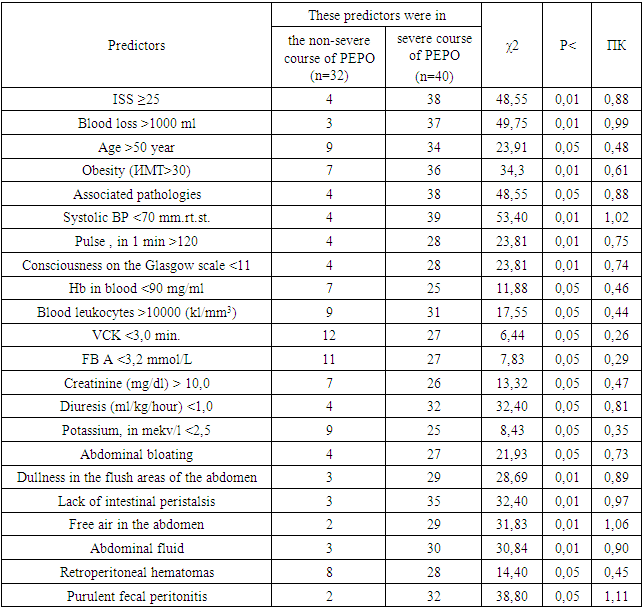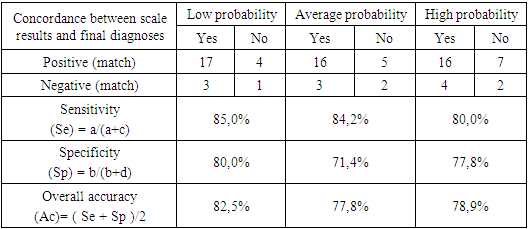-
Paper Information
- Next Paper
- Previous Paper
- Paper Submission
-
Journal Information
- About This Journal
- Editorial Board
- Current Issue
- Archive
- Author Guidelines
- Contact Us
American Journal of Medicine and Medical Sciences
p-ISSN: 2165-901X e-ISSN: 2165-9036
2024; 14(6): 1660-1662
doi:10.5923/j.ajmms.20241406.40
Received: May 30, 2024; Accepted: Jun. 18, 2024; Published: Jun. 20, 2024

Method of Assessing the Severity of the Course of Closed Injuries of Hollow Organs
Mustafakhulov I. B., Norov M. Ch., Mahamadaminov A. G., Djuraeva Z. A.
Samarkand State Medical University, Uzbekistan
Copyright © 2024 The Author(s). Published by Scientific & Academic Publishing.
This work is licensed under the Creative Commons Attribution International License (CC BY).
http://creativecommons.org/licenses/by/4.0/

In this article the authors have developed an integral scale for predicting the probability of a severe course of closed injuries of hollow organs in abdominal traumas on the basis of appropriate calculations, which is characterized by high indicators of sensitivity, specificity and overall accuracy and allows to reliably predict the risk of a severe course of these injuries. Wide application of the integral scale in patients with closed injuries of hollow organs at abdominal traumas allows to optimize the therapeutic-diagnostic process and significantly improve the results of treatment of this severe contingent of urgent patients.
Keywords: Integral scale, Hollow organs, Injuries
Cite this paper: Mustafakhulov I. B., Norov M. Ch., Mahamadaminov A. G., Djuraeva Z. A., Method of Assessing the Severity of the Course of Closed Injuries of Hollow Organs, American Journal of Medicine and Medical Sciences, Vol. 14 No. 6, 2024, pp. 1660-1662. doi: 10.5923/j.ajmms.20241406.40.
Article Outline
1. Introduction
- Despite modern advances in diagnostic technologies, the development of surgical techniques, anesthesiology and intensive care, pharmacology, to date there is no unambiguous solution to the problem of diagnosis and treatment of closed injuries of hollow organs (CLOH) in abdominal injuries. Meanwhile, the prevalence of CLI in the structure of abdominal injuries reaches from 16.3% to 43% [1,7]. LPSO in abdominal traumas belong to the category of extremely life-threatening emergency conditions and are accompanied by high lethality, which, depending on the nature of injuries, ranges from 27% to 35%. It is noteworthy that lethality is persistent and does not tend to decrease [2]. To choose reasonable treatment tactics in patients with ZPPO in abdominal trauma, predicting the probability of severe course of the existing injuries is important. It is quite obvious that such prediction not only allows to choose the tactics of surgical treatment, but also creates an opportunity to determine the volume of necessary measures of preoperative and postoperative intensive careх [3,11].It should be noted that when solving the problem of objective assessment of the severity of the existing LPSO in abdominal injuries, numerous studies pay much attention to the search for independent prognostic factors (designated in modern literature as predictors) of their outcome. It is generally accepted that predictors can be in the form of anatomical criteria that determine the severity of injuries and physiological parameters that characterize the response of functional systems of the body to the injuries [4,8]. By incorporating predictors into a variety of scoring scales and statistical models, researchers attempt to quantitatively rank injury severity within defined intervals and calculate the probability of survival. The best known among the latter are ISS (Injury Severity Score) - Injury Severity Index, RTS (Revised Trauma Score) - Revised Trauma Scale, SAPS - Simplified Assessment of Physiologic Disorders Scale [5,9]. It should be emphasized that the creation of a universal scale is complicated by the variety of injuries and disorders occurring in the body after abdominal trauma, insufficient study of predictors of its outcome. In this regard, the above-mentioned scales are not without certain drawbacks. One of the main drawbacks is that the scoring system used in these scales for evaluating selected predictors is based mainly on the clinical experience of specialists and is subjective in nature. In this case, the established scores cannot fully express the degree of change of predictors, i.e. their prognostic "weight" in assessing the severity of the course of existing CLL [6,10].Therefore, the aim of the present study was to develop an integral scale for predicting the probability of severe STEMI in abdominal trauma.
2. Material and Methods of Research
- We solved this problem by modifying and adapting the well-known ISS and SAPS scales to closed abdominal injuries. In this regard, we set the task of developing an integral scale for predicting the probability of a severe course of STEMI in abdominal trauma. We solved this problem by modifying and adapting the known ISS and SAPS scales to closed abdominal injuries. At the same time, we conducted retrospective studies to determine the prognostic significance and statistical reliability of anthropometric, clinical, instrumental and laboratory risk indicators for the development of severe course of closed abdominal injuries accompanied by damage to the hollow organs of the abdominal cavity. Statistical analysis was performed separately in the groups of patients who did not have severe course of CLAB and in the group of patients who had severe course of the latter. We calculated χ2 values for each of the selected parameters. The critical value of the latter was 3.84. Exceeding of the calculated χ2 values of this critical value was evaluated by us as evidence of statistical reliability of this index (P < 0.01).
3. The Results Obtained and Their Discussion
- As a result of the corresponding calculations, we obtained data indicating statistical reliability and prognostic significance of 22 predictors (Table 1).
|
 , where: PF - predictive factor;xi - investigated feature; В1 - disease 1; В2 - disease 2; Р - probability of feature.After that, the obtained prognostic coefficients were summarized and on the basis of the obtained sum we developed the gradations of prediction of the probability of the development of a severe course of PDVA in abdominal injuries (Table 2.).
, where: PF - predictive factor;xi - investigated feature; В1 - disease 1; В2 - disease 2; Р - probability of feature.After that, the obtained prognostic coefficients were summarized and on the basis of the obtained sum we developed the gradations of prediction of the probability of the development of a severe course of PDVA in abdominal injuries (Table 2.).
|
|
4. Conclusions
- Thus, based on the conducted studies, we can conclude that the proposed integral scale for predicting the probability of a severe course of STEMI in abdominal injuries is characterized by high sensitivity, specificity and overall accuracy and allows to reliably predict the risk of severe course of these injuries.Widespread use of the integral scale in patients with STEMI in abdominal injuries allows to optimize the treatment and diagnostic process and significantly improve the results of treatment of this severe contingent of urgent patients.
 Abstract
Abstract Reference
Reference Full-Text PDF
Full-Text PDF Full-text HTML
Full-text HTML

